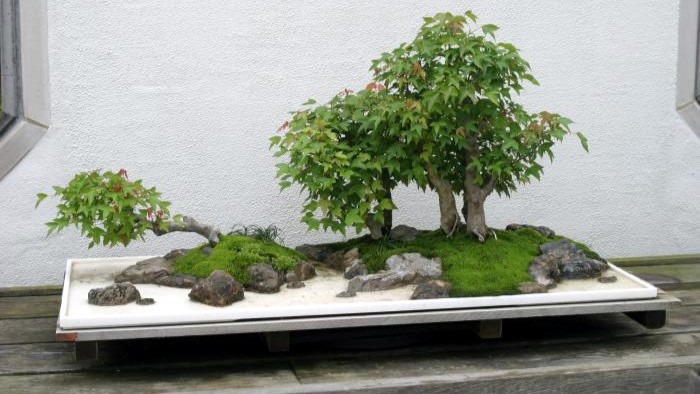Saikei, which translates to “planted landscape,” is a Japanese art form that combines elements of bonsai, bonseki, and bonkei. It is also related to the Chinese art of penjing and the Vietnamese art of hòn non bộ. Saikei involves creating miniature landscapes that incorporate living trees, soil, rocks, water, and other vegetation in a single tray or similar container. The goal of a Saikei landscape is to evoke a sense of a natural location through its overall topography, choice of ground materials, and the species used in its plantings.
The art of Saikei was founded in Japan by Toshio Kawamoto after World War II. Kawamoto was born in 1917, the eldest child of the bonsai master Tokichi Kawamoto, and was trained in the art of bonsai. In 1960, following his father’s death, he ran the family bonsai nursery Meiju-En. He actively promoted the practice of Saikei after this time, publishing two seminal books on Saikei (Bonsai-Saikei and Saikei: Living Landscapes in Miniature) and participating in the creation of the Nippon Bonsai-Saikei Institute and the Nippon Saikei Association.
Saikei Today
Saikei was designed to be an easier practice to participate in than bonsai. A Saikei container provides liberal quantities of soil, easing the burden of careful watering and root pruning that mark bonsai cultivation. Saikei plantings are quick to assemble, with first-time participants able to create an effective result in a few hours. The trees can be very young and therefore inexpensive, and none of the other materials except the tray itself cost much. The trees themselves do not require a great deal of shaping or other manipulation, compared to bonsai’s complex and time-consuming development practices. As a result, Saikei is a good fit for beginners and for those who wish to spend little on the hobby of growing dwarfed trees.
As a particular Saikei ages, some of its trees may grow out of proportion to the rest of the display. This change is expected and in fact is one of the goals of Saikei. The owner has two choices, to reduce the size of the large trees, or to remove them from the Saikei and grow them separately. Reducing their size involves bonsai-related techniques such as pruning. Removing oversize trees from the Saikei leads naturally to potting them individually and cultivating them as bonsai. After removal of these trees, the Saikei can be augmented with new trees, restyled to suit the remaining trees, or dismantled and redesigned to a new plan. In all cases, the trees are retained and continue to be cultivated under the Saikei principle of developing potential new bonsai.
Saikei and Bonsai: A Comparison
While Saikei and Bonsai share some similarities, they also have key differences. Saikei focuses on the evocation of a natural living landscape, rather than on the character of individual trees as emphasized in bonsai. Saikei must contain rocks, which may play the role of mountains, cliff faces, stone outcroppings, stream beds, shorelines, or other aspects of the landscape. They are the skeleton of the landscape, and appear prominently. In bonsai group plantings, rocks are rare and if present are inconspicuous and subjugated to the trees.
Saikei allows multiple species of tree to be placed in a single landscape, and allows other plant forms like flowers and grasses, while multiple plantings in bonsai are typically a single species of tree with moss alone allowed as additional vegetation. Because of this flexibility in plant materials, Saikei can be designed to show the progress of the seasons in much greater variety and detail than can a mono-culture bonsai planting.
| Aspect | Saikei | Bonsai |
| Origin | Japan | China, Japan |
| Focus | Miniature landscapes | Individual trees |
| Rocks | Essential, represent various landscape elements | Rare, if present are inconspicuous |
| Plant Variety | Allows multiple species of trees, flowers, and grasses | Typically a single species of tree, moss allowed as additional vegetation |
| Complexity | Easier to assemble and maintain, suitable for beginners | Requires careful watering, root pruning, and shaping |
| Cost | Generally lower cost due to use of young, inexpensive trees | Can be costly due to the age and rarity of trees used |
| Time | Quick to assemble, trees do not require a great deal of shaping | Time-consuming due to complex development practices |
| Purpose | Evokes a sense of a natural location | Captures the essence of a tree’s character and beauty |
| Container | Liberal quantities of soil, eases the burden of careful watering | Limited soil, requires careful watering and root pruning |
| Evolution | Trees can be removed and grown separately as they grow out of proportion | Trees are carefully pruned and shaped to maintain proportion and style |
The Beauty of Saikei
Saikei is a beautiful and accessible art form that allows individuals to create miniature landscapes that evoke the beauty of nature. Whether you’re a seasoned bonsai enthusiast looking to explore a new art form, or a beginner interested in cultivating dwarfed trees, Saikei offers a unique and rewarding experience. Its simplicity, flexibility, and emphasis on natural landscapes make it a captivating practice that can be enjoyed by all.
